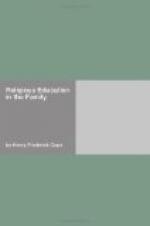Along with the tendency toward communal working and eating we see the tendency to communal living by the development of the apartment building. Since roof-trees are so expensive, and since in a practical age, few of us can afford to pay for sentiment, why not put a dozen families under one roof-tree? True we sacrifice lawns, gardens, natural places for children to play; we lose birds and flowers and the charm of evening hours on porches, or galleries, but think of what we gain in bricks and mortar, in labor saved from splitting wood and shoveling coal, in janitor service! The transition is now complete; the home is simply that item in the economic machinery which will best furnish us storage for our sleeping bodies and our clothes!
We are undoubtedly in a period of great changes in family life, and no family can count on escaping the influence of the change. The one single outstanding and most potent change, so far as the character of family life is concerned, is, in the United States, the rapid polarization of population in the cities. The United States Census Bureau counts all residents in cities of over 8,000 population as “urban.” In 1800 the “urban” population was 4 per cent of the total population; in 1850 it was 12.5 per cent; in 1870, 20.9 per cent; in 1890, 29.2 per cent; in 1900, 33.1 per cent; in 1910 it was estimated at 40 per cent.[2] Here is a trend so clearly marked that we cannot deny its reality, while its significance is familiar to everyone today.
However, the village type remains; there are still many homes where a measure of family unity persists, where at least in one meal daily and, for purposes of sleeping and, occasionally, for the evening hours of recreation, there is a consciousness of home life. Yet the most remote village feels the pressure of change. The few homes conforming to the older ideals are recognized as exceptional. The city draws the village and rural family to itself, and the contagion of its customs and ideals spreads through the villages and affects the forms of living there. Youths become city dwellers and do not cease to scoff at the village unless later years give them wisdom to appreciate its higher values. The standard of domestic organization is established by the city; that type of living is the ideal toward which nearly all are striving.
The important question for all persons is whether the changes now taking place in family life are good or ill. It is impossible to say whether the whole trend is for the better; the many elements are too diverse and often apparently conflicting. Faith in the orderly development of society gives ground for belief that these changes ultimately work for a higher type of family life. The city may be regarded as only a transition stage in social evolution—the compacting of masses of persons together that out of the new fusing and welding may arise new methods of social living. The larger numbers point to more highly developed forms of social organization. When these larger units discover their greater purposes, above factory and mill and store, and realize them in personal values, the city life will be a more highly developed mechanism for the higher life of man. The home life will develop along with that city life.




